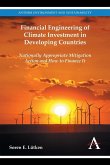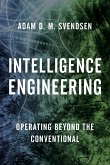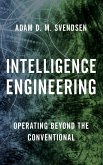- Gebundenes Buch
- Merkliste
- Auf die Merkliste
- Bewerten Bewerten
- Teilen
- Produkt teilen
- Produkterinnerung
- Produkterinnerung
This thorough and accessible text introduces readers to the topic of climate engineering. Landes defines key concepts, presents the major methods and techniques, proposes an evaluative framework for judging whether to embark upon a specific interventions, and reviews the main ...
Andere Kunden interessierten sich auch für
![Politics of the Anthropocene and Climate Crisis in India Politics of the Anthropocene and Climate Crisis in India]() Politics of the Anthropocene and Climate Crisis in India178,99 €
Politics of the Anthropocene and Climate Crisis in India178,99 €![Financial Engineering of Climate Investment in Developing Countries Financial Engineering of Climate Investment in Developing Countries]() Søren E. LütkenFinancial Engineering of Climate Investment in Developing Countries44,99 €
Søren E. LütkenFinancial Engineering of Climate Investment in Developing Countries44,99 €![International Politics of Superheroes International Politics of Superheroes]() Mariano TurziInternational Politics of Superheroes88,99 €
Mariano TurziInternational Politics of Superheroes88,99 €![Intelligence Engineering Intelligence Engineering]() Adam D. M. SvendsenIntelligence Engineering41,99 €
Adam D. M. SvendsenIntelligence Engineering41,99 €![International Politics of Superheroes International Politics of Superheroes]() Mariano TurziInternational Politics of Superheroes34,99 €
Mariano TurziInternational Politics of Superheroes34,99 €![Intelligence Engineering Intelligence Engineering]() Adam D. M. SvendsenIntelligence Engineering77,99 €
Adam D. M. SvendsenIntelligence Engineering77,99 €![The Technological Republic The Technological Republic]() Alexander C. KarpThe Technological Republic13,99 €
Alexander C. KarpThe Technological Republic13,99 €-
-
-
This thorough and accessible text introduces readers to the topic of climate engineering. Landes defines key concepts, presents the major methods and techniques, proposes an evaluative framework for judging whether to embark upon a specific interventions, and reviews the main ...
Produktdetails
- Produktdetails
- Verlag: Rowman & Littlefield Publishers
- Seitenzahl: 274
- Erscheinungstermin: 9. April 2024
- Englisch
- Abmessung: 235mm x 157mm x 21mm
- Gewicht: 600g
- ISBN-13: 9781538145609
- ISBN-10: 153814560X
- Artikelnr.: 59985505
- Herstellerkennzeichnung
- Libri GmbH
- Europaallee 1
- 36244 Bad Hersfeld
- gpsr@libri.de
- Verlag: Rowman & Littlefield Publishers
- Seitenzahl: 274
- Erscheinungstermin: 9. April 2024
- Englisch
- Abmessung: 235mm x 157mm x 21mm
- Gewicht: 600g
- ISBN-13: 9781538145609
- ISBN-10: 153814560X
- Artikelnr.: 59985505
- Herstellerkennzeichnung
- Libri GmbH
- Europaallee 1
- 36244 Bad Hersfeld
- gpsr@libri.de
Xavier Landes is an associate professor at the Stockholm School of Economics in Riga. In addition, he has held positions at Université de Montréal, University of Toronto, and Copenhagen University. Landes's areas of expertise are political and moral philosophy. He has published on various topics such as multiculturalism, the welfare state, public insurance, and happiness. Climate change and climate alteration constitute his current focuses of research and teaching.
Acknowledgements
Abbreviations and Acronyms
Introduction: Climate Change and Alteration in the Anthropocene
How Accurate is Geoengineering Denomination?
Intensifying Climate Concerns
Would Climate Engineering Announce a New Era?
Anthropocene Controversies
The Onset of the Anthropogenic Influence
Mitigation, Adaptation, and Climate Engineering
Rationale and Structure of the Book
Chapter 1: What is Climate Engineering?
Deliberate
Large-Scale
Countering Anthropogenic Climate Change
Is Climate Engineering Reducible to Conventional Climate Policy?
CDR and Mitigation
SRM and Adaptation
Chapter 2: An Evaluative Framework
How to Evaluate Climate Engineering?
Feasibility
Technological Maturity
Scalability
Efficiency
Permissibility
Intrinsic Moral Value
Risks and Uncertainty
Distributive Justice
Procedural Justice
Social Acceptability
Intergenerational Justice
Regulation and Governance
Preferability
Complicating Factors
A Glimpse into Comparative Principles
Technological Difference and Moral Non-Equivalence
Chapter 3: Climate Engineering Methods I: Carbon Dioxide Removal (CDR)
What is CDR?
Land-Based Carbon Sinks Enhancement
Land Management and Ecosystem Restoration
Land Sequestration
Land Enhanced Weathering
Ocean-Based Carbon Sinks Enhancement
Ocean Enhanced Weathering
Ocean Pumps
Macroalgae Cultivation
Fully Engineered Carbon Sinks
Carbon Capture and Storage/Sequestration (CCS)
Bioenergy with Carbon Capture and Storage/Sequestration (BECCS)
Direct Air Capture and Storage/Sequestration (DACS)
CDR: A General Assessment
Feasibility
Permissibility
Preferability
Chapter 4: Climate Engineering Methods II: Solar Radiation Management (SRM)
What is SRM?
Surface Albedo Modification
Urban Surface Brightening (USB)
Crop Albedo
Tropospheric Interventions
Marine Cloud Brightening (MCB)
Cirrus Cloud Thinning (CCT)
Stratospheric Interventions
Space-Based Interventions
SRM: A General Assessment
Feasibility
Permissibility
Preferability
Chapter 5: Engineering the Climate: Arguments and Objections
Mitigation Gap and Necessity
The Distinction Between Research and Deployment
Reasons for the Distinction (and in Support of Research)
Reasons Against the Distinction (and Research)
Governing Research
Justifications for Climate Engineering
Objections to Climate Engineering
Efficiency Objections
Precautionary Objections
Capture Objections
Political Objections
Moral Corruption
Conclusion
Bibliography
About the Author
Abbreviations and Acronyms
Introduction: Climate Change and Alteration in the Anthropocene
How Accurate is Geoengineering Denomination?
Intensifying Climate Concerns
Would Climate Engineering Announce a New Era?
Anthropocene Controversies
The Onset of the Anthropogenic Influence
Mitigation, Adaptation, and Climate Engineering
Rationale and Structure of the Book
Chapter 1: What is Climate Engineering?
Deliberate
Large-Scale
Countering Anthropogenic Climate Change
Is Climate Engineering Reducible to Conventional Climate Policy?
CDR and Mitigation
SRM and Adaptation
Chapter 2: An Evaluative Framework
How to Evaluate Climate Engineering?
Feasibility
Technological Maturity
Scalability
Efficiency
Permissibility
Intrinsic Moral Value
Risks and Uncertainty
Distributive Justice
Procedural Justice
Social Acceptability
Intergenerational Justice
Regulation and Governance
Preferability
Complicating Factors
A Glimpse into Comparative Principles
Technological Difference and Moral Non-Equivalence
Chapter 3: Climate Engineering Methods I: Carbon Dioxide Removal (CDR)
What is CDR?
Land-Based Carbon Sinks Enhancement
Land Management and Ecosystem Restoration
Land Sequestration
Land Enhanced Weathering
Ocean-Based Carbon Sinks Enhancement
Ocean Enhanced Weathering
Ocean Pumps
Macroalgae Cultivation
Fully Engineered Carbon Sinks
Carbon Capture and Storage/Sequestration (CCS)
Bioenergy with Carbon Capture and Storage/Sequestration (BECCS)
Direct Air Capture and Storage/Sequestration (DACS)
CDR: A General Assessment
Feasibility
Permissibility
Preferability
Chapter 4: Climate Engineering Methods II: Solar Radiation Management (SRM)
What is SRM?
Surface Albedo Modification
Urban Surface Brightening (USB)
Crop Albedo
Tropospheric Interventions
Marine Cloud Brightening (MCB)
Cirrus Cloud Thinning (CCT)
Stratospheric Interventions
Space-Based Interventions
SRM: A General Assessment
Feasibility
Permissibility
Preferability
Chapter 5: Engineering the Climate: Arguments and Objections
Mitigation Gap and Necessity
The Distinction Between Research and Deployment
Reasons for the Distinction (and in Support of Research)
Reasons Against the Distinction (and Research)
Governing Research
Justifications for Climate Engineering
Objections to Climate Engineering
Efficiency Objections
Precautionary Objections
Capture Objections
Political Objections
Moral Corruption
Conclusion
Bibliography
About the Author
Acknowledgements
Abbreviations and Acronyms
Introduction: Climate Change and Alteration in the Anthropocene
How Accurate is Geoengineering Denomination?
Intensifying Climate Concerns
Would Climate Engineering Announce a New Era?
Anthropocene Controversies
The Onset of the Anthropogenic Influence
Mitigation, Adaptation, and Climate Engineering
Rationale and Structure of the Book
Chapter 1: What is Climate Engineering?
Deliberate
Large-Scale
Countering Anthropogenic Climate Change
Is Climate Engineering Reducible to Conventional Climate Policy?
CDR and Mitigation
SRM and Adaptation
Chapter 2: An Evaluative Framework
How to Evaluate Climate Engineering?
Feasibility
Technological Maturity
Scalability
Efficiency
Permissibility
Intrinsic Moral Value
Risks and Uncertainty
Distributive Justice
Procedural Justice
Social Acceptability
Intergenerational Justice
Regulation and Governance
Preferability
Complicating Factors
A Glimpse into Comparative Principles
Technological Difference and Moral Non-Equivalence
Chapter 3: Climate Engineering Methods I: Carbon Dioxide Removal (CDR)
What is CDR?
Land-Based Carbon Sinks Enhancement
Land Management and Ecosystem Restoration
Land Sequestration
Land Enhanced Weathering
Ocean-Based Carbon Sinks Enhancement
Ocean Enhanced Weathering
Ocean Pumps
Macroalgae Cultivation
Fully Engineered Carbon Sinks
Carbon Capture and Storage/Sequestration (CCS)
Bioenergy with Carbon Capture and Storage/Sequestration (BECCS)
Direct Air Capture and Storage/Sequestration (DACS)
CDR: A General Assessment
Feasibility
Permissibility
Preferability
Chapter 4: Climate Engineering Methods II: Solar Radiation Management (SRM)
What is SRM?
Surface Albedo Modification
Urban Surface Brightening (USB)
Crop Albedo
Tropospheric Interventions
Marine Cloud Brightening (MCB)
Cirrus Cloud Thinning (CCT)
Stratospheric Interventions
Space-Based Interventions
SRM: A General Assessment
Feasibility
Permissibility
Preferability
Chapter 5: Engineering the Climate: Arguments and Objections
Mitigation Gap and Necessity
The Distinction Between Research and Deployment
Reasons for the Distinction (and in Support of Research)
Reasons Against the Distinction (and Research)
Governing Research
Justifications for Climate Engineering
Objections to Climate Engineering
Efficiency Objections
Precautionary Objections
Capture Objections
Political Objections
Moral Corruption
Conclusion
Bibliography
About the Author
Abbreviations and Acronyms
Introduction: Climate Change and Alteration in the Anthropocene
How Accurate is Geoengineering Denomination?
Intensifying Climate Concerns
Would Climate Engineering Announce a New Era?
Anthropocene Controversies
The Onset of the Anthropogenic Influence
Mitigation, Adaptation, and Climate Engineering
Rationale and Structure of the Book
Chapter 1: What is Climate Engineering?
Deliberate
Large-Scale
Countering Anthropogenic Climate Change
Is Climate Engineering Reducible to Conventional Climate Policy?
CDR and Mitigation
SRM and Adaptation
Chapter 2: An Evaluative Framework
How to Evaluate Climate Engineering?
Feasibility
Technological Maturity
Scalability
Efficiency
Permissibility
Intrinsic Moral Value
Risks and Uncertainty
Distributive Justice
Procedural Justice
Social Acceptability
Intergenerational Justice
Regulation and Governance
Preferability
Complicating Factors
A Glimpse into Comparative Principles
Technological Difference and Moral Non-Equivalence
Chapter 3: Climate Engineering Methods I: Carbon Dioxide Removal (CDR)
What is CDR?
Land-Based Carbon Sinks Enhancement
Land Management and Ecosystem Restoration
Land Sequestration
Land Enhanced Weathering
Ocean-Based Carbon Sinks Enhancement
Ocean Enhanced Weathering
Ocean Pumps
Macroalgae Cultivation
Fully Engineered Carbon Sinks
Carbon Capture and Storage/Sequestration (CCS)
Bioenergy with Carbon Capture and Storage/Sequestration (BECCS)
Direct Air Capture and Storage/Sequestration (DACS)
CDR: A General Assessment
Feasibility
Permissibility
Preferability
Chapter 4: Climate Engineering Methods II: Solar Radiation Management (SRM)
What is SRM?
Surface Albedo Modification
Urban Surface Brightening (USB)
Crop Albedo
Tropospheric Interventions
Marine Cloud Brightening (MCB)
Cirrus Cloud Thinning (CCT)
Stratospheric Interventions
Space-Based Interventions
SRM: A General Assessment
Feasibility
Permissibility
Preferability
Chapter 5: Engineering the Climate: Arguments and Objections
Mitigation Gap and Necessity
The Distinction Between Research and Deployment
Reasons for the Distinction (and in Support of Research)
Reasons Against the Distinction (and Research)
Governing Research
Justifications for Climate Engineering
Objections to Climate Engineering
Efficiency Objections
Precautionary Objections
Capture Objections
Political Objections
Moral Corruption
Conclusion
Bibliography
About the Author








